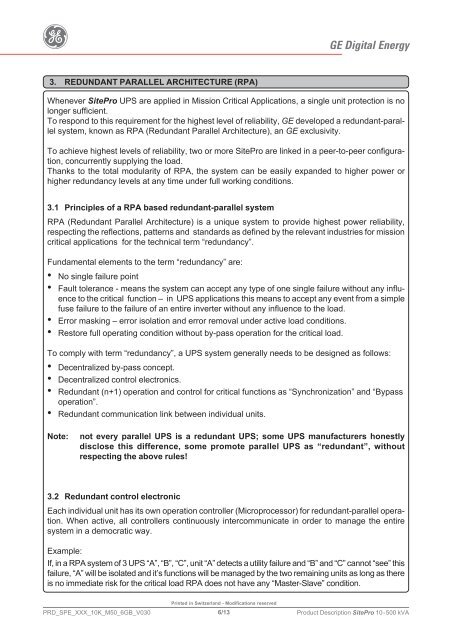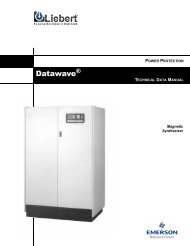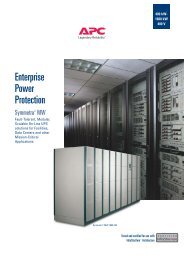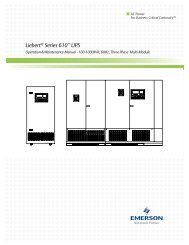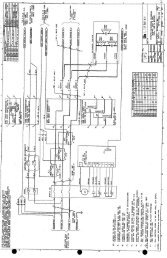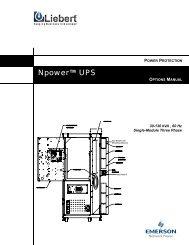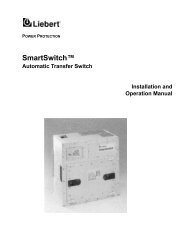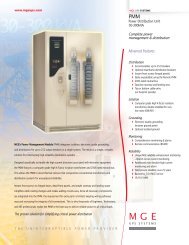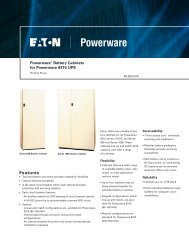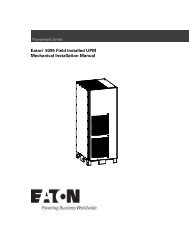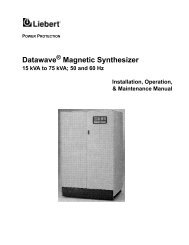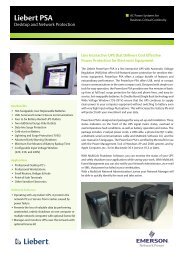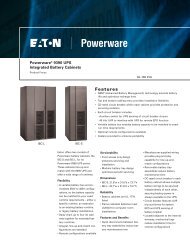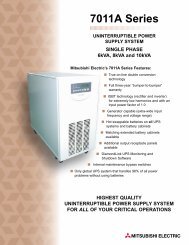GE SitePro Brochure.pdf - Gruber Power
GE SitePro Brochure.pdf - Gruber Power
GE SitePro Brochure.pdf - Gruber Power
Create successful ePaper yourself
Turn your PDF publications into a flip-book with our unique Google optimized e-Paper software.
g<br />
<strong>GE</strong> Digital Energy<br />
3. REDUNDANT PARALLEL ARCHITECTURE (RPA)<br />
Whenever <strong>SitePro</strong> UPS are applied in Mission Critical Applications, a single unit protection is no<br />
longer sufficient.<br />
To respond to this requirement for the highest level of reliability, <strong>GE</strong> developed a redundant-parallel<br />
system, known as RPA (Redundant Parallel Architecture), an <strong>GE</strong> exclusivity.<br />
To achieve highest levels of reliability, two or more <strong>SitePro</strong> are linked in a peer-to-peer configuration,<br />
concurrently supplying the load.<br />
Thanks to the total modularity of RPA, the system can be easily expanded to higher power or<br />
higher redundancy levels at any time under full working conditions.<br />
3.1 Principles of a RPA based redundant-parallel system<br />
RPA (Redundant Parallel Architecture) is a unique system to provide highest power reliability,<br />
respecting the reflections, patterns and standards as defined by the relevant industries for mission<br />
critical applications for the technical term “redundancy”.<br />
Fundamental elements to the term “redundancy” are:<br />
• No single failure point<br />
• Fault tolerance - means the system can accept any type of one single failure without any influence<br />
to the critical function – in UPS applications this means to accept any event from a simple<br />
fuse failure to the failure of an entire inverter without any influence to the load.<br />
• Error masking – error isolation and error removal under active load conditions.<br />
• Restore full operating condition without by-pass operation for the critical load.<br />
To comply with term “redundancy”, a UPS system generally needs to be designed as follows:<br />
• Decentralized by-pass concept.<br />
• Decentralized control electronics.<br />
• Redundant (n+1) operation and control for critical functions as “Synchronization” and “Bypass<br />
operation”.<br />
• Redundant communication link between individual units.<br />
TEMPORARY<br />
Note:<br />
not every parallel UPS is a redundant UPS; some UPS manufacturers honestly<br />
disclose this difference, some promote parallel UPS as “redundant”, without<br />
respecting the above rules!<br />
3.2 Redundant control electronic<br />
Each individual unit has its own operation controller (Microprocessor) for redundant-parallel operation.<br />
When active, all controllers continuously intercommunicate in order to manage the entire<br />
system in a democratic way.<br />
Example:<br />
If, in a RPA system of 3 UPS “A”, “B”, “C”, unit “A” detects a utility failure and “B” and “C” cannot “see” this<br />
failure, “A” will be isolated and it’s functions will be managed by the two remaining units as long as there<br />
is no immediate risk for the critical load RPA does not have any “Master-Slave” condition.<br />
PRD_SPE_XXX_10K_M50_6GB_V030<br />
Printed in Switzerland - Modifications reserved<br />
6/13<br />
Product Description <strong>SitePro</strong> 10-500 kVA


